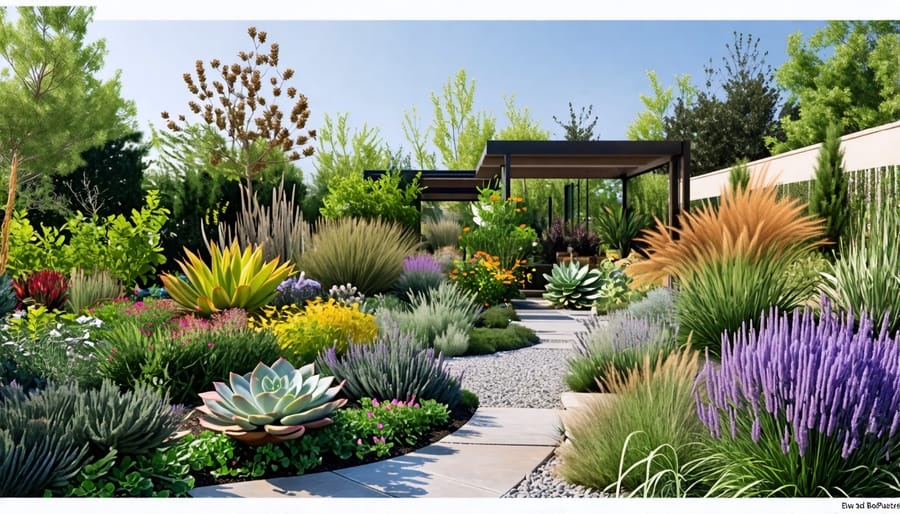Climate-Resilient Plants to Future-Proof Your Garden

When the weather starts to change dramatically, selecting appropriate plants for your garden should be your top priority.
These robust plants can endure dry periods and intense rainfall, conserving water and reducing maintenance requirements. Additionally, they provide habitat for local wildlife, contributing to environmental balance.
By selecting these plant varieties, your yard will be vibrant and contribute to planetary health. It is also an effective approach to preparing your space for unpredictable weather while preserving resources and maintaining ecological equilibrium.
Let’s look deeply into how to pick the perfect plants so you can effectively future-proof your garden.
What Are Climate-Resilient Plants?
Its exactly as the name suggests. Each plant has in-built traits which help it create specific weather conditions. These can be things like drought, torrential rain or even searing heat. Moreover, they also rely on complicated root systems. They allow the plant to tap into water resources which are unattainable by other plants.
For instance, succulents famously store water, while certain native plants can only thrive in their original habitats. The enduring lavender and yarrow have an exceptional ability to flower beautifully with nominal water requirements.
Integrating this flora into your gardening space not only lessens the dependence on chemical additives and water consumption–thus yielding cost benefits–but it also transforms your garden into a green haven impervious to harsh weather conditions.
Additionally, this vibrant, varied garden setting offers crucial support to pollinators and local wildlife, enhancing its inherent attractiveness.
Resorting to such environmentally friendly gardening methods reflects a proactive stance towards sustainable gardening and an effective response to environmental change.
Benefits of Using Climate-Resilient Plants
All climates are different. Therefore, consider the pros and cons of where you live as that has some practical advantages. For instance, if you use drought-resistant plants, you may minimise your watering requirements.
This results in reduced upkeep and irrigation costs. Also, such plants have a lesser necessity for pruning and removing wilted flowers. This further simplifies your gardening tasks and makes your job easier.
Furthermore, the growth of hardy flora leads to lower spending on pesticides and plant food. These plants naturally repel pests, so they reduce the need for chemical solutions.
Diverse plant textures also create appealing environments. This supplies vital nutrients and refuge for crucial pollinators. All this aids and increases your local biodiversity.
Choosing the Right Plants for Your Climate
Selection is everything. Pick the right greens for your local climate and watch your garden thrive.
You need to take into account your region’s specific weather patterns and determine whether these greens can handle it. Consider factors such as variations in temperature and rainfall, etc.
Review local climate information to identify resilient plant species that will prosper but require little care to thrive.
Be sure to engage with regional gardening experts or agricultural services. They possess comprehensive insights regarding plant species that will successfully grow in your specific climate.
Thus, you can make informed decisions that support an attractive and environmentally responsible plot.
Examine each plant’s growth patterns and requirements for flourishing. Some require ample space, while others perform better in clusters—the essence of a healthy, thriving garden lies in striking the right balance.
It’s not just about the aesthetic appeal, mindful placement affects plant interactions and, subsequently, their overall well-being.
How to Incorporate Climate-Resilient Plants in Your Garden
Consider revising your selection of water-dependent plants, opting instead for those designed for survival. Prioritising drought-resistant species such as lavender and succulents can conserve water without compromising on beauty.
Traditional lawns have their charm, yet clever exchanges can yield landscapes that remain verdant with minimal effort.
Designing for Efficiency
Design your garden by grouping vegetation that shares the same sunlight and watering needs. This strategy simplifies upkeep and minimises unnecessary water usage. Place easy-care plants in sunlit spots where they flourish with minimal additional hydration.
Group together hardy, drought-resistant varieties such as Lavender, Sedum, and Yarrow for sun-drenched, arid regions. Conversely, in shadowy, damp sections, unite Hostas, Ferns, and Astilbes.
For gardeners feeling uncertain about plant selection or design, professional gardening consultants offer invaluable expertise.
Professionals in the field can offer customised consultancy, carefully considering your unique setting, weather conditions, and horticultural abilities.
Their direction assists in converting garden obstacles into charming, sustainable outdoor havens, achieving this with limited anxiety and optimised success.
Soil Health and Seasonal Planning
Utilise mulch and compost to maintain soil health and moisture retention. These techniques support plant growth while minimising frequent watering requirements. Consider seasonal variations to ensure attractiveness throughout the year.
A well-structured garden blossoms all year round, continually transforming and teeming with wildlife. Each plant contributes to the perpetual rhythm of the garden, providing a sense of life and movement.
A successful design takes into account the annual calendar; plants are chosen to not simply fill spaces, but to stress the changing seasons. The aim is to avoid barren periods, instead, the changing seasons should evoke a sense of evolution.
Winter recedes as Snowdrops sprout, followed closely by an influx of Tulips and Daffodils bringing forth spring.
Summer arrives with the vibrancy of Delphiniums and Marigolds, followed by autumn dressed in a profusion of Asters and Chrysanthemums. The seamless rhythm ensures the garden never becomes stagnant.
Testing ideas and settings is essential. Experiment with positioning, contrasting textures, and varying plant heights to create a textured, pleasing space. Picture Lavender and Rosemary adorning pathways, stimulating a multisensory experience beyond mere sight.
For the backdrop, towering plants like Foxgloves and Hollyhocks impart intriguing vertical elements. Concurrently, Creeping Thyme and Heuchera establish an evergreen, texture-filled blanket at the base. These not only protect the earth but also boost the overall garden layout.
Adding to the flower arrangements, motion creates a sense of depth. The soft sound of water features, the sight of birds darting amongst the nesting boxes, and the delicate fluttering of butterflies above nectar-rich flowers.
A well-designed garden is more than a visual experience, it is alive, filled with sounds and sensations.
Maintaining a Climate-Resilient Garden
A climate-resilient space can thrive despite unpredictable weather patterns, reducing the need for excessive care and resources. Adopting a few key strategies will ensure your garden remains sustainable and healthy throughout the year.
Simple Maintenance Strategies
Maintaining an attractive garden requires implementing easy and simple techniques. Start by watering to encourage robust root development, enabling vegetation to locate water sources during dry periods.
Apply organic fertilisers to support plant growth and soil health. This environmentally friendly approach attracts beneficial insects while promoting planetary well-being.
Regularly inspect your space to identify potential pest or disease issues. Even resilient flora will encounter challenges. When problems arise, prioritise natural solutions over chemical interventions to preserve vegetation health.
Seasonal garden cleanup through composting fallen leaves and plant material reduces waste and enriches soil conditions.
Embracing Native Flora for Resilience
Selecting native plants represents a smart approach to creating a space that is capable of withstanding unpredictable British weather conditions.
These have evolved to tolerate local temperature fluctuations and precipitation patterns, thus requiring minimal water and maintenance.
Additionally, native varieties provide exceptional support for local wildlife, offering food and shelter for numerous species. Their flowers and seeds constitute critical resources for birds and pollinators.
By incorporating them, gardeners contribute to wildlife preservation amidst increasing urban development and agricultural activities.
Consider introducing native plant species such as Common Bluebell, Foxglove, or Wild Marjoram which demonstrate exceptional durability and aesthetic appeal. These plants tolerate challenging environmental conditions while creating visually stunning landscapes.
Creating a Biodiverse Garden with Climate-Resilient Plants
The aspect of balancing ecology plays a pivotal role in the modern gardening ethos. This approach allows gardens to rally against global warming and possible pest issues effectively.
One should foster self-sufficient ecosystems by including a variety of plant species that require little upkeep. Gardens with a mix of plant heights, hues, and flowering times draw beneficial wildlife such as bees, birds and butterflies.
Tall botanicals such as Sunflowers or Hollyhocks act as sanctuaries and nourishment sources for pollinators, whereas blooms of medium height like Echinacea and Coreopsis present colourful, nectar-abundant alternatives.
Ground protectors such as Creeping Thyme and Sedum safeguard the soil from erosion. Drought-tolerant plants, chosen for their resilience and flourishing potential under tough conditions, help conserve ecological balance.
While withstanding severe environments, they offer sustenance to the local wildlife. Plants like Lavender are great supporters of bees and thrive in arid conditions, whilst Sea Holly or Yarrow cope with heat and feed pollinators.
Remember to integrate other elements, such as wildlife shelters and water resources, to promote biodiversity.
Future-Proofing Your Garden Against Climate Change
Your garden can thrive even in harsh climates, as you’re probably convinced by now. You now know to look for plants that can handle temperature swings and abrupt shifts in rainfall. Keep an eye on weather trends to adapt plant nurturing methods successfully.
Incorporate environmentally conscious measures like harvesting rainwater and composting to boost the quality of your soil and enhance its water-holding capacity. These methods bolster plant vitality and lessen resource usage.
Interact with nearby communities to share wisdom, plant suggestions and personal encounters. This synergy not only readies gardens for tough climates but also cultivates local relationships.
Conclusion
Embracing sustainable gardening practices creates environmentally responsible outdoor spaces. Climate-adaptable plants require minimal water, simplify maintenance, and reduce dependency on artificial additives.
You’ll help wildlife immensely and help your local habitat. Moreover, you’ll create an enduring green paradise in your backyard, which will be a sight to behold.





